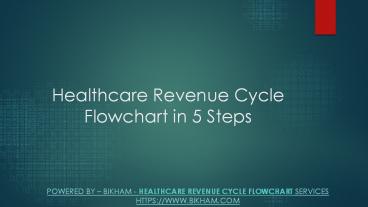5 Steps of Healthcare Revenue Cycle Flowchart - PowerPoint PPT Presentation
Title:
5 Steps of Healthcare Revenue Cycle Flowchart
Description:
5 Steps of Healthcare Revenue Cycle Flowchart by Bikham - Outsource Medical billing with us to increase your revenue with speedy claims for more visit us on – PowerPoint PPT presentation
Number of Views:353
Updated: 1 May 2019
Slides: 9
Provided by:
Medicalbillingexpert
Category:
Medicine, Science & Technology
Tags:
Title: 5 Steps of Healthcare Revenue Cycle Flowchart
1
Healthcare Revenue Cycle Flowchart in 5 Steps
- Powered by Bikham - Healthcare Revenue Cycle
flowchart Serviceshttps//www.Bikham.com
2
Medical Billing RCM Flow Chart
- Healthcare revenue cycle management is a complex
and complicated process that can drain resources
when not properly managed. It takes considerable
time and expertise to create and manage a
well-maintained system that runs efficiently. An
effective healthcare revenue cycle
process maximizes organizational profits and
keeps revenues pouring in. Medical professionals
currently spend more valuable time and resources
on the revenue cycle than any other industry. A
healthy medical revenue cycle process works in
tandem with other software and automates the
revenue cycle management. - It also aides in the migration to value based
reimbursement, and it maximizes organizational
performance and regulatory compliance while
minimizing the cost per claim. The best way to
examine the process is with a healthcare revenue
cycle flowchart.
3
Healthcare Revenue Cycle Flowchart
- The revenue cycle starts when a patient makes an
appointment for services, and it continues until
full payment has been remitted. While the
healthcare revenue cycle flowchart is unique to
each organization, some fundamental
characteristics remain unchanged. - For instance, every healthcare revenue cycle
flowchart has five sections. Of course, the names
will vary between organizations, but the general
contents of each section remain the same. Some
flowcharts are, however, more detailed than
others. The five main sections of the healthcare
revenue cycle flowchart include pre-claim,
front-end, transactional and back-end.
4
1. Pre-Claim
- The pre-claim section of the healthcare revenue
cycle is the smallest section. However, it is
still inherently important to the rest of the
process. This section includes things such as
provider credentialing and contract
negotiations. EDI and ERA enrollment fits into
this section along with the pricing and fee
schedule for the organization. EDI is an acronym
for Electronic Data Interchange, and ERA stands
for Electronic Remittance Advice. These are both
critical for regulatory compliance and claims
processing.
5
2. Front End
- The front-end section of the healthcare revenue
cycle flowchart begins with the patient
appointment and continues until the end of the
patient visit. It includes everything from
patient registration to deductibles, coding and
charge capture. This part of the process is
crucial to the rest of the healthcare revenue
cycle. This is where a patients contact
information is documented, and current insurance
coverage is verified. Co-pays and deductibles are
also collected at this point. A best practices
revenue cycle process also includes payment
arrangements for any outstanding balance that may
not be covered by insurance.
6
3. Transactional
- The transactional section of the healthcare
revenue cycle flowchart includes everything from
charge entry to cash reconciliation. This also
includes posting payments, claim scrubbing and
EFT processing, among other things. This is where
charges are entered into the system, claims are
submitted, and payments are posted for services
rendered. It is the largest and most crucial part
of the healthcare revenue cycle flowchart. A
mistake in this section of the revenue cycle can
cost the organization dearly, resulting in slow
payments or the denial of claims. Regulatory
compliance is also crucial in the transactional
section of the flowchart.
7
4. Back End
- The back end of the revenue cycle management
process flow chart includes things such as
checking the status of claims, patient statements
and analyzing claim denials. Claims may be
resubmitted for payment and patients need to be
contacted to make payments on an outstanding
balance. This is where appeals are submitted when
necessary, and patients who refuse to pay may be
sent to collections. The back-end section of the
rcm cycle flow chart is where additional revenue
is captured beyond the transactional section.
8
5. Efficiency
- A healthy revenue cycle is efficient. It helps
streamline the revenue collection process while
promoting regulatory compliance and minimizing
costs. It also ensures an organization is
collecting the maximum amount of revenue
available for their services. Utilizing a
healthcare revenue cycle flowchart helps
organizations isolate inefficiencies in the
process. It allows them to target specific
elements of the revenue cycle that need
improvement. The reference to key indicators and
benchmarks of best practices are essential! As
healthcare revenue cycles become more complex,
they present core challenges that require an
innovative approach. Your best next step may be
a medical billing, to identify the gaps in
completing the revenue cycle flowchart.































